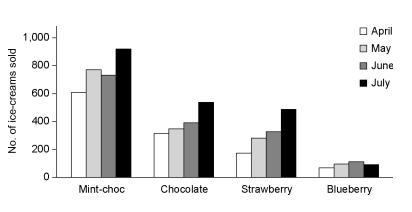快速查题-ACCA英国注册会计师试题
ACCA英国注册会计师
筛选结果
共找出2330题
- 不限题型
- 不定项选择题
- 单选题
- 填空题
- 材料题
- 简答题
- 论述题
The diagram represents the behaviour of a cost item as the level of output changes:Which ONE of the following situations is described by the graph?

The data may be illustrated by the following chart. What type of chart is it?
Which one of the following statements is true?
The table below shows a company's sales figures for the first six months of the year.What kind of graph or chart would you use to show the fluctuations of total monthly sales figures across the six months?
The following statements refer to strategic planning:
(i) It is concerned with quantifiable and qualitative matters.
(ii) It is mainly undertaken by middle management in an organisation.
(iii) It is concerned predominantly with the long term.Which of the statements are correct?
The following statements relate to responsibility centres:(i) Return on capital employed is a suitable measure of performance in both profit and investment centres.(ii) Cost centres are found in manufacturing organisations but not in service organisations.(iii) The manager of a revenue centre is responsible for both sales and costs in a part of an organisation.Which of the statements are incorrect?
A paint manufacturer has a number of departments. Each department is located in a separate building on the same factory site. In the mixing department the basic raw materials are mixed together in very large vessels. These are then moved on to the colour adding department where paints of different colours are created in these vessels. In the next department - the pouring department - the paint is poured from these vessels into litre sized tins. The tins then go on to the labelling department prior to going on to the finished goods department.The following statements relate to the paint manufacturer:
(i) The mixing department is a cost centre.
(ii) A suitable cost unit for the colour adding department is a litre tin of paint.
(iii) The pouring department is a profit centre.Which statement or statements is/are correct?
Which of the following is/are primary sources of data?
(i) Historical records of transport costs to be used to prepare forecasts for budgetary planning
(ii) The Annual Abstract of Statistics, published by the Office for National Statistics in the United Kingdom
(iii) Data collected by a bank in a telephone survey to monitor the effectiveness of the bank's customer services
The following statements relate to different types of data:
(i) Secondary data are data collected especially for a specific purpose
(ii) Discrete data can take on any value
(iii) Qualitative data are data that cannot be measured
(iv) Population data are data arising as a result of investigating a group of people or objects
Which of the statements are true?
Which of the following statements are false?
(i) If a sample is selected using random sampling, it will be free from bias.
(ii) A sampling frame is a numbered list of all items in a sample.
(iii) In cluster sampling there is very little potential for bias.
(iv) In quota sampling, investigators are told to interview all the people they meet up to a certain quota.


